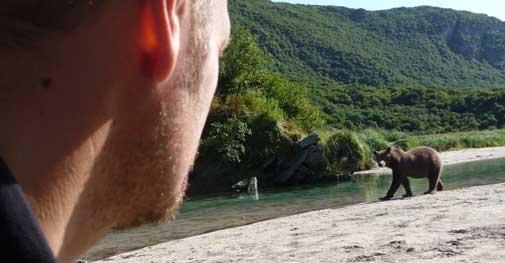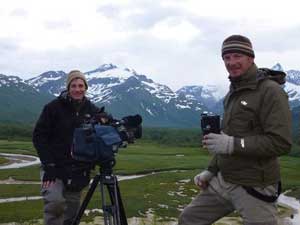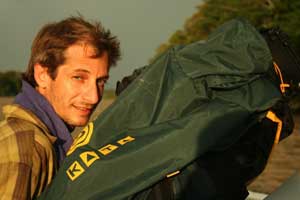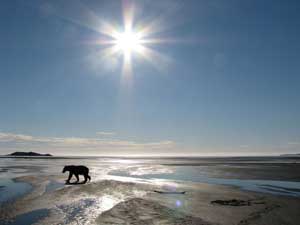
The PBS series Nature has presented some memorable wildlife programming over the nearly three decades it has been on the air. Over the next three Sundays, Nature will memorably return a term to the wild, when it reminds viewers that mama grizzlies don't care about tea, can't see Russia and can be pretty darn accommodating to outsiders.
Bears of the Last Frontier (8 p.m. ET Sunday, May 8, 15 and 22 -- check local listings) is a video record of more than a year of following grizzlies, black bears and polar bears through many parts of Alaska with a couple of cameras, a whole lot of expertise and even more chutzpah. It's a mostly fascinating, sometimes scary, always interesting look at America's most undeveloped and wildlife-rich state.

Bear expert Chris Morgan is host. He and producer-writer-videographer Joe Pontecorvo started an adventure that took them across the state, south-to-north, in the spring of 2009 when a sea plane took them to a part of the Alaska Peninsula that's heavily populated by grizzly bears -- and left them there.
Bears normally are solitary, Pontecorvo said in a recent phone interview, but the high number of them in this area has turned them into more social animals. They tolerate each other more than bears usually do, and they also mostly tolerated being watched, followed and filmed.
The story here, as in later segments as they move through the state, shows bears to be intelligent, resourceful, powerful and potentially intimidating by nature. It also shows that mother bears, whether polar, black or grizzly, are devoted to and protective of their cubs, while being surprisingly habituated to two-legged intruders. The three-part series will satisfy anyone who is fascinated by the behavior of predator animals in the wild, but has neither the resources nor the courage to get this close in fulfilling that fascination.
Encounters this close with these powerful creatures always carry a large share of risk. That's demonstrated during the first hour, when the filmmakers' vantage point for watching grizzlies hunting salmon turns from relatively safe to dangerous as a large bear charges toward them. Nothing disastrous happens, but Morgan, who has studied bears in many habitats for half his life, and Pontecorvo, whose wildlife credits have put him close to many dangerous animals, don't hide their extreme relief when the danger has passed.
Subsequent stops on the state-long trip take them to the large city of Anchorage, where black bears and moose wander populated neighborhoods that used to be their wilderness. Black bears, though the smallest of the trio of bears shown in the series, still can be dangerous. And the human efforts to keep them under control and away from pets and small children and other easily harmed targets demonstrate how lower-48 obstacles like commutes, shopping malls and client meetings are so lamely tame in comparison.
They next visit Denali National Park, where the grizzlies are as solitary and elusive as their Peninsula relatives are social and plentiful. A single bear can cover an area the size of Yellowstone National Park, Pontecorvo said. It's the second of three types of grizzlies seen in the series, and shows how one breed of bear can change and adapt in radically different ways, depending on the setting.

The third hour begins in polar bear territory, and it's here, said Pontecorvo, that he had his biggest scare. Polar bears prey on other large animals, he explained, and their need for quiet stalking and a coat that blends them into the surroundings makes them extra dangerous. He was filming polar bears that were feeding on a whale carcass when it was pointed out one of the bears had circled behind him, putting him in potential danger. He immediately headed toward the safety of the truck they were using.
"Open the door," he said.
"Just a minute," came the reply from inside.
"I don't have a minute," was his reasoned but firm response.
His wife, Nimmida, got the message and opened the door. Yes, wife. They had gotten married, he said, shortly before the Alaska trip began, and she came along as a second videographer and sound tech. She did so willingly and happily, ruling out any motive for her "Just a minute" being retaliatory for such an unusual honeymoon.
The final stop is in the Brooks Range, where still another grizzly subset is encountered. A mother and three cubs are filmed as she teaches them how to catch salmon. They may be the first humans these bears ever have encountered, and the well-grown cubs are curious about their visitors. Morgan literally talks the cub into not coming any farther -- eliminating a situation that might have made the mother react in a politically incorrect manner.

More than 500 hours of video were shot and post production took more than six months. He said there was plenty of good material to have added a fourth hour. He also explained how they used solar chargers to keep their cameras powered and how there was enough sunlight to avoid the dilemma of drained batteries when miles away from a conventional power source.
Protection largely was pepper spray and flares, though there were times when the participants carried shotguns. The shotguns weren't an option when on national parkland, Pontecorvo said, because federal policy bans them. When possible, a metal electrified wire surrounded the tents.
The mix of a year of bears, the famous Alaskan mosquitos and enough cold weather for an ordinary person's lifetime hasn't changed his mind about the great payback for this adventure, or other similarly tough ones he has experienced. He looks forward, he said, to each assignment, no matter the terrain or the critter being followed.
"The more perilous the situation, the better the shot," Pontecorvo explained.